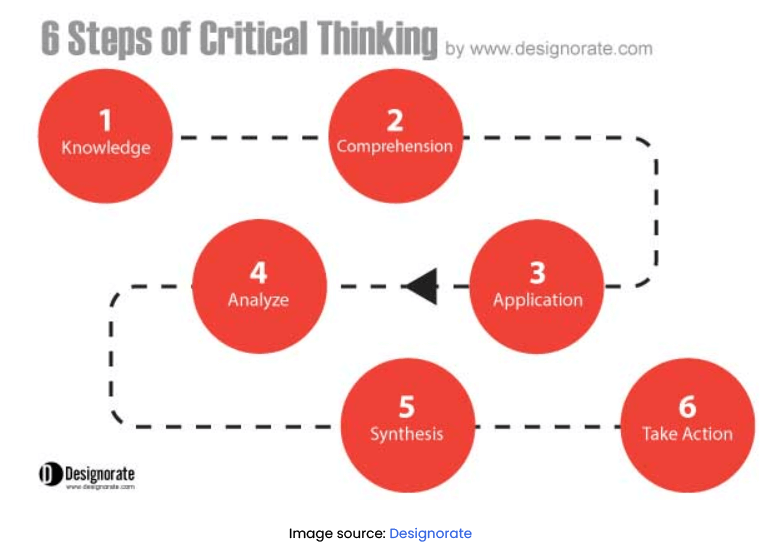
Click the button to start reading
Catch These Benefits! 13 Examples of Critical Thinking in the Workplace
Your team is dealing with a sudden decrease in sales, and you’re not sure why.
When this happens, do you quickly make random changes and hope they work? Or do you pause, bring your team together, and analyze the problem using critical thinking?
In the pages ahead, we’ll share examples of critical thinking in the workplace to show how critical thinking can help you build a successful team and business.
Ready to make critical thinking a part of your office culture?
Let’s dive in!
What Is Critical Thinking? A Quick Definition
Critical thinking is the systematic approach of being a sharp-minded analyst. It involves asking questions, verifying facts, and using your intellect to make decisions and solve problems.
The process of thinking critically is built upon a foundation of six major steps:

- Knowledge
- Comprehension
- Application
- Analysis
- Synthesis
- Creation/Action
First, you gather “knowledge” by learning about something and understanding it. After that, you put what you’ve learned into action, known as “application.” When you start looking closely at the details, you do the “analysis.”
After analyzing, you put all those details together to create something new, which we call “synthesis.” Finally, you take action based on all your thinking, and that’s the “creation” or “action” step.
Examples of Critical Thinking in the Workplace
Even if the tasks are repetitive, or even if employees are required to follow strict rules, critical thinking is still important. It helps to deal with unexpected challenges and improve processes.
Let’s delve into 13 real examples to see how critical thinking works in practice.
1. Evaluating the pros and cons of each option
Are you unsure which choice is the best? Critical thinking helps you look at the good and bad sides of each option. This ensures that you make decisions based on facts and not just guesses.
Product development: For example, a product development team is deciding whether to launch a new product. They must evaluate the pros and cons of various features, production methods, and marketing strategies to make an informed decision. Obviously, the more complete their evaluation is, the better decisions they can make.
2. Breaking down complex problems into smaller, manageable parts
In the face of complex problems, critical thinkers are able to make the problem easier to solve. How? They create a step-by-step process to address each component separately.
Product deliveries and customer support. Imagine you work in a customer service department, and there has been a sudden increase in customer complaints about delayed deliveries. You need to figure out the root causes and come up with a solution.
So, you break down the problem into pieces – the shipping process, warehouse operations, delivery routes, customer communication, and product availability. This helps you find out the major causes, which are:
- insufficient staff in the packaging department, and
- high volume of orders during specific weeks in a year.
So, when you focus on smaller parts, you can understand and address each aspect better. As a result, you can find practical solutions to the larger issue of delayed deliveries.
3. Finding, evaluating and using information effectively
In today’s world, information is power. Using it wisely can help you and your team succeed. And critical thinkers know where to find the right information and how to check if it’s reliable.
Market research: Let’s say a marketing team is conducting market research to launch a new product. They must find, assess, and use market data to understand customer needs, competitor tactics, and market trends. Only with this information at hand can they create an effective marketing plan.
4. Paying attention to details while also seeing the bigger picture
Are you great at noticing small things? But can you also see how they fit into the larger picture? Critical thinking helps you do both. It’s like zooming in and out with a camera. Why is it essential? It helps you see the full story and avoid tunnel vision.
Strategic planning. For instance, during strategic planning, executives must pay attention to the details of the company’s financial data, market changes, and internal potential. At the same time, they must consider the bigger picture of long-term goals and growth strategies.
5. Making informed decisions by considering all available information
Ever made a choice without thinking it through? Critical thinkers gather all the facts before they decide. It ensures your decisions are smart and well-informed.
Data analysis. For example, data analysts have to examine large datasets to discover trends and patterns. They use critical thinking to understand the significance of these findings, get useful insights, and provide recommendations for improvement.
6. Recognizing biases and assumptions
Too many workplaces suffer from unfair and biased decisions. Make sure yours isn’t on this list. Critical thinkers are self-aware and can spot their own biases. Obviously, this allows them to make more objective decisions.
Conflict resolution. Suppose a manager needs to mediate a conflict between two team members. Critical thinking is essential to understand the underlying causes, evaluate the validity of each person’s opinion, and find a fair solution.
Hiring decisions. Here’s another example. When hiring new employees, HR professionals need to critically assess candidates’ qualifications, experience, and cultural fit. At the same time, they have to “silence” their own assumptions to make unbiased hiring decisions.
7. Optimizing processes for efficiency
Critical thinking examples in the workplace clearly show how teams can improve their processes.
Customer service. Imagine a company that sells gadgets. When customers have problems, the customer service team reads their feedback. For example, if many people struggle to use a gadget, they think about why that’s happening. Maybe the instructions aren’t clear, or the gadget is too tricky to set up.
So, they work together to make things better. They make a new, easier guide and improve the gadget’s instructions. As a result, fewer customers complain, and everyone is happier with the products and service.
8. Analyzing gaps and filling them in
Discovering problems in your company isn’t always obvious. Sometimes, you need to find what’s not working well to help your team do better. That’s where critical thinking comes in.
Training and development. HR professionals, for instance, critically analyze skill gaps within the organization to design training programs. Without deep analysis, they can’t address specific needs and upskill their employees.
9. Contributing effectively to team discussions
In a workplace, everyone needs to join meetings by saying what they think and listening to everyone else. Effective participation, in fact, depends on critical thinking because it’s the best shortcut to reach collective decisions.
Team meetings. In a brainstorming session, you and your colleagues are like puzzle pieces, each with a unique idea. To succeed, you listen to each other’s thoughts, mix and match those ideas, and together, you create the perfect picture – the best plan for your project.
10. Contributing effectively to problem-solving
Effective problem-solving typically involves critical thinking, with team members offering valuable insights and solutions based on their analysis of the situation.
Innovative SaaS product development. Let’s say a cross-functional team faces a challenging innovation problem. So, they use critical thinking to brainstorm creative solutions and evaluate the feasibility of each idea. Afterwards, they select the most promising one for further development.
11. Making accurate forecasts
Understanding critical thinking examples is essential in another aspect, too. In fact, critical thinking allows companies to prepare for what’s coming, reducing unexpected problems.
Financial forecasting. For example, finance professionals critically assess financial data, economic indicators, and market trends to make accurate forecasts. This data helps to make financial decisions, such as budget planning or investment strategies.
12. Assessing potential risks and recommending adjustments
Without effective risk management, you’ll constantly face issues when it’s too late to tackle them. But when your team has smart thinkers who can spot problems and figure out how they might affect you, you’ll have no need to worry.
Compliance review. Compliance officers review company policies and practices to ensure they align with relevant laws and regulations. They want to make sure everything we do follows the law. If they find anything that could get us into trouble, they’ll suggest changes to keep us on the right side of the law.
13. Managing the crisis
Who else wants to minimize damage and protect their business? During a crisis, leaders need to think critically to assess the situation, make rapid decisions, and allocate resources effectively.
Security breach in a big IT company. Suppose you’ve just discovered a major security breach. This is a crisis because sensitive customer data might be at risk, and it could damage your company’s reputation.
To manage this crisis, you need to think critically. First, you must assess the situation. You investigate how the breach happened, what data might be compromised, and how it could affect your customers and your business. Next, you have to make decisions. You might decide to shut down the affected systems to prevent further damage. By taking quick, well-planned actions, you can minimize the damage and protect your business.

Encouraging Critical Thinking in Your Team: A Brief Manager’s Guide
According to Payscale’s survey, 60% of managers believe that critical thinking is the top soft skill that new graduates lack. Why should you care? Well, among these graduates, there’s a good chance that one could eventually become a part of your team down the road.
So, how do you create a workplace where critical thinking is encouraged and cultivated? Let’s find out.
Step 1: Make Your Expectations Clear
First things first, make sure your employees know why critical thinking is important. If they don’t know how critical it is, it’s time to tell them. Explain why it’s essential for their growth and the company’s success.
Step 2: Encourage Curiosity
Do your employees ask questions freely? Encourage them to! A workplace where questions are welcomed is a breeding ground for critical thinking. And remember, don’t shut down questions with a “That’s not important.” Every question counts.
Step 3: Keep Learning Alive
Encourage your team to keep growing. Learning new stuff helps them become better thinkers. So, don’t let them settle for “I already know enough.” Provide your team with inspiring examples of critical thinking in the workplace. Let them get inspired and reach new heights.
Step 4: Challenge, Don’t Spoon-Feed
Rethink your management methods, if you hand your employees everything on a silver platter. Instead, challenge them with tasks that make them think. It might be tough, but don’t worry. A little struggle can be a good thing.
Step 5: Embrace Different Ideas
Do you only like ideas that match your own? Well, that’s a no-no. Encourage different ideas, even if they sound strange. Sometimes, the craziest ideas lead to the best solutions.
Step 6: Learn from Mistakes
Mistakes happen. So, instead of pointing fingers, ask your employees what they learned from the mistake. Don’t let them just say, “It’s not my fault.”
Step 7: Lead the Way
Are you a critical thinker yourself? Show your employees how it’s done. Lead by example. Don’t just say, “Do as I say!”
Wrapping It Up!
As we’ve seen, examples of critical thinking in the workplace are numerous. Critical thinking shows itself in various scenarios, from evaluating pros and cons to breaking down complex problems and recognizing biases.
The good news is that critical thinking isn’t something you’re born with but a skill you can nurture and strengthen. It’s a journey of growth, and managers are key players in this adventure. They can create a space where critical thinking thrives by encouraging continuous learning.
Remember, teams that cultivate critical thinking will be pioneers of adaptation and innovation. They’ll be well-prepared to meet the challenges of tomorrow’s workplace with confidence and competence.
















